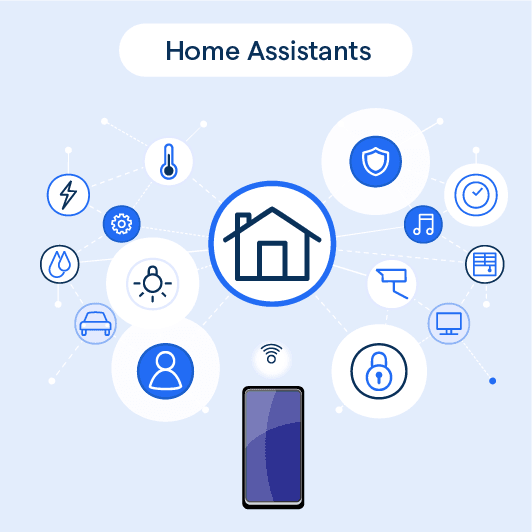What are Home Assistants?
Home Assistants are smart, voice-activated devices designed to make your life easier and more convenient. They use Artificial Intelligence (AI) to respond to your voice commands and perform various tasks using connected smart devices in your home. These assistants are your new best friends – they can play music, provide weather updates, control smart home appliances, answer questions, and much more!
Key Terms: Home Assistants
Here are some key terms frequently used when talking about Home Assistants:
Welcome to Home Assistants
Home Assistants are revolutionizing our way of life, serving as a hub for managing smart home devices, interpreting voice commands, and learning our patterns.
Smart Home Defined
Smart homes are residences that integrate devices and systems to automate everyday tasks. As the house's orchestra conductor, Home Assistants allow for smoother and more intelligent control over your living environment.
Unpacking Voice Recognition
Voice recognition allows Home Assistants to convert spoken language into text or actions. Say "good morning," and your assistant could start brewing your coffee and turn on your favorite news channel.
Artificial Intelligence - AI
AI is the brain behind Home Assistants. Through machine learning, your assistant can learn from your behaviors and personalize its assistance to suit your unique preferences.
The Role of Task Automation
Home Assistants can automate repetitive tasks. From setting alarms to streaming music, these digital allies bring an extra level of hands-free convenience to your home.
Smart Device Integration
Through integration with smart devices, Home Assistants can control various elements like lights, thermostats, and security systems. Just a simple voice command and the magic happens!
Features and Capabilities of Home Assistants
Home Assistants have a host of impressive features and capabilities. Let's explore how each feature impacts our daily routines.
Voice Control
Voice control and recognition in Home Assistants allow users to speak their instructions instead of manual inputs. This hands-free approach makes accessing information, controlling devices, and multitasking much easier, especially in situations where your hands are occupied.
Smart Home Integration
By seamlessly connecting with various smart devices in your home, Home Assistants create an integrated ecosystem that provides convenience and centralized control. Users can manage lighting, temperature, security systems, and entertainment with simple spoken commands, enhancing the overall living experience.
AI-Powered Learning
Through AI and machine learning, Home Assistants adapt to better understand users' preferences and routines. This feature enables more personalized suggestions and anticipates needs, making the virtual companion a proactive part of users' lives.
Task Automation
Automating tasks like setting reminders, alarms, and managing calendars helps users stay organized and be more productive. Home Assistants aid in streamlining daily routines, providing information, answering questions, and even tackling administrative work like shopping lists or reservations.
Multi-User Recognition
Home Assistants can identify and differentiate between household members' voices. This feature allows for personalized responses and tailored settings for each user, making the system more versatile and inclusive for the whole family.
Hands-Free Phone Calls
Home Assistants facilitate hands-free phone calls, text message handling, and notifications. This feature keeps users updated and connected while staying focused on ongoing tasks, leading to more efficient communication.
Entertainment Hub
Home Assistants can play music, access news, and control TVs or streaming devices. By becoming a personal entertainment hub, they cater to user preferences, enhance relaxation, and support recreational activities.
How do Home Assistants work?
Home Assistants use artificial intelligence to make our lives easier. Let's understand how they work:
Voice Recognition and Interpretation
At the core of a home assistant's functionality is voice recognition. Once activated by a 'wake word,' the assistant records your voice, transforming the audio into text. The assistant then interprets what has been said using Natural Language Processing (NLP) to understand commands and fulfill requests.
Connection with the Cloud
The interpreted commands are processed through the cloud connection of the home assistants. By leveraging extensive databases and computational power in the cloud, home assistants can respond to all sorts of requests, ranging from weather updates to setting timers and playing music.
Integration with Smart Home Devices
Home Assistants act as control hubs for smart home devices. Whether it's dimming the lights, turning on the air conditioner, or locking the doors, these tasks can be carried out through voice commands to the home assistant.
Machine Learning for Personalization
Home Assistants learn from user interactions and habits over time and tailor their responses accordingly. They provide personalized service and recommendations, giving users a better, more individualized experience.
Privacy and Security
Data Collection
Home Assistants typically record and analyze your voice commands to improve their accuracy and performance. However, most devices allow you to review and delete this data if desired.
Privacy Settings
To protect your privacy, Home Assistants provide options to disable voice recording, control data sharing, and limit third-party app access. Be sure to customize these settings according to your preferences.
Wake Word Security
Home Assistants have a designated wake word that activates their listening capabilities. This ensures that the device only responds when you intentionally address it.
Frequently Asked Questions (FAQs)

How do I set up a Home Assistant?
Setting up a Home Assistant is a breeze! Just follow the manufacturer's instructions, connect it to your Wi-Fi, and use the accompanying app to complete the setup process.
Can I control my smart devices with a Home Assistant?
Absolutely! Home Assistants are designed to control a wide range of smart devices, including lights, thermostats, locks, and more. Just link them together through the device's app.
Can I use different Home Assistants in different rooms?
Yes, you can! Having Home Assistants in multiple rooms allows for convenient access to your assistant's features no matter where you are in your home. Each assistant operates independently.
What is the difference between voice recognition and wake word?
Voice recognition is the technology that allows a Home Assistant to understand and interpret your spoken language. Wake word is the specific phrase used to activate the assistant and get its attention.
Can I use my Home Assistant to make phone calls?
Yes! Depending on the specific device and its capabilities, you can use your Home Assistant to make hands-free phone calls to contacts in your phone's address book or through internet-based calling services.

